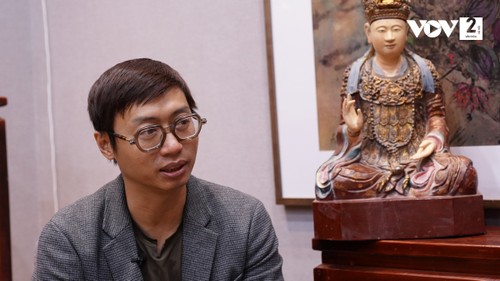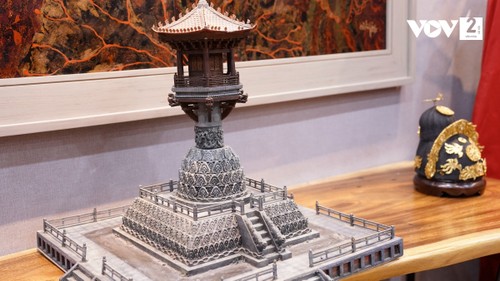 Architect Dinh Viet Phuong Architect Dinh Viet Phuong |
In 2002, when Phuong was a student of the Hanoi Architecture University, he nurtured a dream of digitizing Vietnam’s cultural heritages and architecture. Two years later, he began collaborating with a volunteer team from the University to create 3D simulations of streets in Hanoi’s Old Quarter. They exhibited artworks depicting three eras of the capital city, the late 19th century, the early 20th century, and the winter of 1946.
“First, we scan the original version using 3D technology. Then we collect related documents and connect them to the original artifacts. To stay alive the living cultural heritages need to be used to create regenerative products. I have worked on this idea for more than 20 years. I set up a volunteer team of people who share my passion for cultural heritages and preserving them,” said Phuong.
Tuyet Nguyen, one of Phuong’s colleagues, said,“Phuong is a dedicated person who has worked very hard to explore Vietnam’s culture and history. This work requires passion and dedication. If our cultural heritages are digitized and posted on social networks, it will be easier for people to get access to them.”
Without any specific training in archeology, Phuong and his colleagues have reconstructed numerous architectural structures using 3D graphics technology. These include the ancient streets of Hanoi, the stone pillar at Dam pagoda in Bac Ninh, and Hien Lam pavilion in Hue.
In 2010, Phuong designed all the slideshow images of Vietnamese heritages and history used for the 1,000th anniversary of Thang Long-Hanoi.
He also helped digitalize the artifacts at the Quang Ninh provincial museum, produced a video clip being shown at the Ha Giang museum, developed software to manage artifacts, and provided VR and AR solutions.
 3D graphics technology is used to reconstruct the stone pillar at Dạm pagoda in Bac Ninh. (Photo: VOV) 3D graphics technology is used to reconstruct the stone pillar at Dạm pagoda in Bac Ninh. (Photo: VOV) |
Phuong is currently digitizing national treasures related to Buddhism, and provides consultation to localities on digitizing their cultural heritages.
“3D technology permeates all aspects of life, including the fields of heritage restoration and digitization. 3D printing technology is the best way to digitalize artifacts. To preserve a heritage, we need to create a reproduction,” said Phuong.
The digitization of heritages will create a standard database that artists, authors, and archeologists can use to promote and develop Vietnamese cultural values in the era of digital transformation.
“Phuong has supported my projects with documents and digitized motifs and patterns found on ancient costumes. All the products made by Phuong and his company are highly applicable to cultural heritages,” designer Nguyen Thi Nga said.
Phuong won the Bui Xuan Phai – Love for Hanoi award in 2010 for his contribution to preserving and promoting Hanoi heritages, and was one of 100 outstanding young Hanoi intellectuals honored at the 1,000th anniversary of Thang Long-Hanoi in 2010.